Seven Russian writers who were also great artists
Russia’s great writers were Renaissance men and women. Many of them could have been prominent in other fields. Today RIR celebrates the writers who were also visual artists – painters and illustrators – of great merit. Some of their magnificent art work is on exhibit in museums.
Alexander Pushkin (1799–1837)
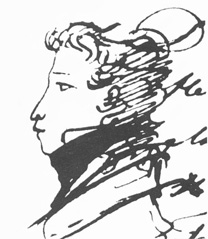 |
| Alexander Pushkin. The self-portrait. Source: Public sources |
Perhaps without even realizing it, Pushkin fans are familiar with the great Russian poet’s artistic style. He is better known for his legacies in poetry, prose, Romanticism and even music – so many of his works inspired composers, particularly Tchaikovsky.
Yet hardly anyone talks about his visual legacy: Almost all his manuscripts contain sketches of faces, people, animals, landscapes and casual scenes. Pushkin was very particular about the design of his books, and readers can find many sketches of book covers and illustrations in his notes.
Pushkin’s favorite theme was the self-portrait. His distinctive profile is well known to readers thanks to the poet’s pencil and ink drawings.
Mikhail Lermontov (1814–1841)
 |
| Mikhail Lermontov. View of Tiflis. Source: Public sources |
Lermontov became famous with his requiem for Pushkin. Ban he is also known as “poet of the Caucasus.” Like Pushkin, he wooed the public, who adored him. Also like Pushkin, he died in a tragic duel at a young age.
Less known is Lermontov’s life as a visual artist: He used various techniques for his drawings: pencils, watercolors, oils and ink. His works include some quick sketches and caricatures as well as elaborate oil paintings.
Lermontov was especially fond of the characters and landscapes of the Caucasus Mountains, which he said were close to his heart. Lermontov had no formal training as an artist, but his works highlight his literary images.
Vassily Zhukovsky (1783–1852)
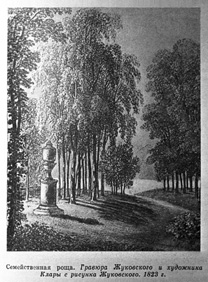 |
| Vassily Zhukovsky. Familial grove. Source: ITAR-TASS |
Zhukovsky was an artist and confidant of the famous Russian painter Karl Bryullov. He took up painting while at Moscow University’s school for the nobility. He used paints, pencils and was an accomplished engraver. An avid traveller, Zhukovsky left behind numerous albums of landscapes, cityscapes and places in Russia and European countries. He was also a talented portrait artist. Many of his prints and engravings are based on his own sketches.
Maximilian Voloshin (1877–1932)
Voloshin was the founder of the so-called Cimmerian School of painting. The imaginary country of Cimmeria, which he was compelled to render in his paintings, was based on his beloved Crimean Peninsula on the Black Sea.
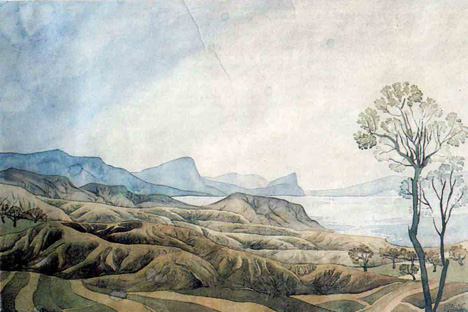 |
| Maximilian Voloshin. From Meganom. Source: The State Museum of Literature |
Voloshin preferred to paint watercolor landscapes, to which he often attached verses: “Your humid light and ivory shadows lend the rocks a turquoise shade.” Maximilian Voloshin studied art in Paris. His works are now in many museums, including the Tretyakov Gallery and the Pushkin Museum of Fine Arts.
Vladimir Mayakovsky (1893–1930)
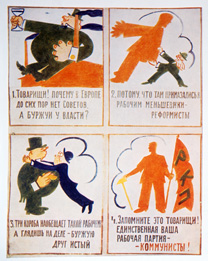 |
| Vladimir Mayakovsky. Poster for the Russian State Telegraph Agency. Source: ITAR-TASS |
A Futurist in verse and art, the Soviet poet was a master of the poster. He painted throughout his childhood and graduated from the Moscow School of Painting, Sculpture and Architecture – the only school that admitted Mayakovsky, who had served a prison term. After the Revolution, he threw all his energy into creating a new art for the proletariat. He worked for the Russian State Telegraph Agency (ROSTA) and combined drawing and poetry to help create an emerging genre, the revolutionary poster.
Alexander Zinovyev (1922–2006)
The great philosopher and satirist Zinovyev did not take his own dabbling in art seriously. He was better known for his novels (“Yawning Heights”) and biting satire.
“I drew caricatures of my classmates at school, my mates in the army, students and teachers at my faculty at Moscow University, colleagues at work. Later I began painting portraits of friends and domestic scenes,” Zinovyev said. His wife collected his works.
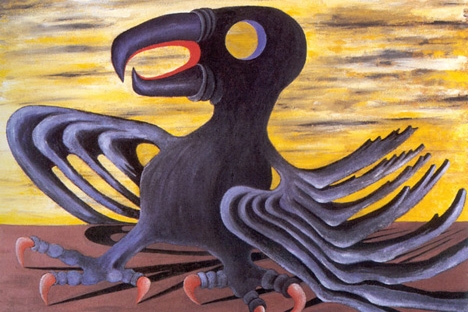 |
| Alexander Zinovyev. Germany. Source: Public sources |
He began to exhibit actively after being exiled from the Soviet Union in 1978. He lived abroad, mostly in Germany, for 21 years, but ultimately returned to Russia in 1999. His first Moscow exhibition was in 2000, six years before his death.
Yuri Koval (1938–1995)
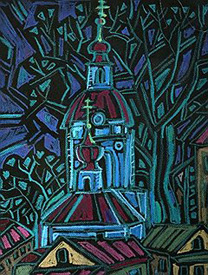 |
| Yuri Koval. View of Moscow. Source: Public sources |
Popular children’s writer and member of the editorial board of the cult Soviet children’s magazine “Murzilka,” Yuri Koval also earned a degree as an art teacher – one of his many degrees. He was as brilliant an artist as he was a writer, producing spectacular illustrations for many writers. Koval attended the well-known monumental sculpture studio. He immersed himself in drawing, art, mosaic, enamel and frescoes. He used to say that artists were the best people he had met on his life’s journey.
Based on materials from Ogoniok magazine.
All rights reserved by Rossiyskaya Gazeta.
Subscribe
to our newsletter!
Get the week's best stories straight to your inbox